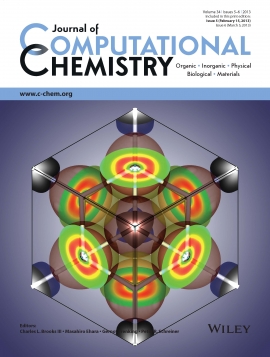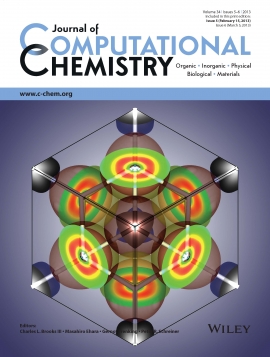P. Bultinck
A New Mean-Field Method Suitable for Strongly Correlated Electrons: Computationally Facile Antisymmetric Products of Nonorthogonal Geminals
Abstract
We propose an approach to the electronic structure problem based on noninteracting electron pairs that has similar computational cost to conventional methods based on noninteracting electrons. In stark contrast to other approaches, the wave function is an antisymmetric product of nonorthogonal geminals, but the geminals are structured so the projected Schrödinger equation can be solved very efficiently. We focus on an approach where, in each geminal, only one of the orbitals in a reference Slater determinant is occupied. The resulting method gives good results for atoms and small molecules. It also performs well for a prototypical example of strongly correlated electronic systems, the hydrogen atom chain.
A size-consistent approach to strongly correlated systems using a generalized antisymmetrized product of nonorthogonal geminals
Abstract
Inspired by the wavefunction forms of exactly solvable algebraic Hamiltonians, we present several wavefunction ansatze. These wavefunction forms are exact for two-electron systems; they are size consistent; they include the (generalized) antisymmetrized geminal power, the antisymmetrized product of strongly orthogonal geminals, and a Slater determinant wavefunctions as special cases. The number of parameters in these wavefunctions grows only linearly with the size of the system. The parameters in the wavefunctions can be determined by projecting the Schrödinger equation against a test-set of Slater determinants; the resulting set of nonlinear equations is reminiscent of coupled-cluster theory, and can be solved with no greater than O (N5) scaling if all electrons are assumed to be paired, and with O (N6) scaling otherwise. Based on the analogy to coupled-cluster theory, methods for computing spectroscopic properties, molecular forces, and response properties are proposed.
Extended random phase approximation method for atomic excitation energies from correlated and variationally optimized second-order density matrices
Reply to ‘comment on “extending hirshfeld-I to bulk and periodic materials”’

Abstract
The issues raised in the comment by Manz are addressed through the presentation of calculated atomic charges for NaF, NaCl, MgO, SrTiO3 , and La2Ce2O7 , using our previously presented method for calculating Hirshfeld-I charges in solids (Vanpoucke et al., J. Comput. Chem. doi: 10.1002/jcc.23088). It is shown that the use of pseudovalence charges is sufficient to retrieve the full all-electron Hirshfeld-I charges to good accuracy. Furthermore, we present timing results of different systems, containing up to over 200 atoms, underlining the relatively low cost for large systems. A number of theoretical issues are formulated, pointing out mainly that care must be taken when deriving new atoms in molecules methods based on “expectations” for atomic charges.
 Open Access version available at UGent repository
Open Access version available at UGent repositoryExtending Hirshfeld-I to bulk and periodic materials

Abstract
In this work, a method is described to extend the iterative Hirshfeld-I method, generally used for molecules, to periodic systems. The implementation makes use of precalculated pseudopotential-based electron density distributions, and it is shown that high-quality results are obtained for both molecules and solids, such as ceria, diamond, and graphite. The use of grids containing (precalculated) electron densities makes the implementation independent of the solid state or quantum chemical code used for studying the system. The extension described here allows for easy calculation of atomic charges and charge transfer in periodic and bulk systems. The conceptual issue of obtaining reference densities for anions is discussed, and the delocalization problem for anionic reference densities originating from the use of a plane wave basis set is identified and handled.
 Open Access version available at UGent repository
Open Access version available at UGent repositoryTuning of CeO2 buffer layers for coated superconductors through doping
Abstract
The appearance of microcracks in cerium oxide (CeO 2) buffer layers, as used in buffer layer architectures for coated superconductors, indicates the presence of stress between this buffer layer and the substrate. This stress can originate from the differences in thermal expansion or differences in lattice parameters between the CeO 2 buffer layer and the substrate. In this article, we study, by means of ab initio density functional theory calculations, the influence of group IV doping elements on the lattice parameter and bulk modulus of CeO 2. Vegard's law behavior is found for the lattice parameter in systems without oxygen vacancies, and the Shannon crystal radii for the doping elements are retrieved from the lattice expansions. We show that the lattice parameter of the doped CeO 2 can be matched to that of the La 2Zr 2O 7 coated NiW substrate substrate for dopant concentrations of about 5%, and that bulk modulus matching is either not possible or would require extreme doping concentrations. [All rights reserved Elsevier].
 Open Access version available at UGent repository
Open Access version available at UGent repositorySelf-consistent methods constrained to a fixed number of particles in a given fragment and its relation to the electronegativity equalization method
Abstract
The variational procedure of the Hartree–Fock and Kohn–Sham methods can be modified by adding one or more constraints that fix the number of electrons in a given number of molecular fragments. The corresponding Euler–Lagrange equations lead to a modified Fock matrix, where the contribution from the constraints only depends on the overlap matrix, when using the Mulliken or Hirshfeld atoms-in-molecules method. For all compounds in the test set, the energy shows a quadratic dependence on the fixed charges. This behavior provides a procedure to obtain the atomic electronegativity and hardness parameters in the
electronegativity equalization method.
Influence of electron correlation and degeneracy on the Fukui matrix and extension of frontier molecular orbital theory to correlated quantum chemical methods
Abstract
The Fukui function is considered as the diagonal element of the Fukui matrix in position space, where the Fukui matrix is the derivative of the one particle density matrix (1DM) with respect to the number of electrons. Diagonalization of the Fukui matrix, expressed in an orthogonal orbital basis, explains why regions in space with negative Fukui functions exist. Using a test set of molecules, electron correlation is found to have a remarkable effect on the eigenvalues of the Fukui matrix. The Fukui matrices at the independent electron model level are mathematically proven to always have an eigenvalue equal to exactly unity while the rest of the eigenvalues possibly differ from zero but sum to zero. The loss of idempotency of the 1DM at correlated levels of theory causes the loss of these properties. The influence of electron correlation is examined in detail and the frontier molecular orbital concept is extended to correlated levels of theory by defining it as the eigenvector of the Fukui matrix with the largest eigenvalue. The effect of degeneracy on the Fukui matrix is examined in detail, revealing that this is another way by which the unity eigenvalue and perfect pairing of eigenvalues can disappear.
Considerations on describing non-singlet spin states in variational second order density matrix methods
Abstract
Despite the importance of non-singlet molecules in chemistry, most variational second order density matrix calculations have focused on singlet states. Ensuring that a second order density matrix is derivable from a proper N-electron spin state is a difficult problem because the second order density matrix only describes one- and two-particle interactions. In pursuit of a consistent description of spin in second order density matrix theory, we propose and evaluate two main approaches: we consider constraints derived from a pure spin state and from an ensemble of spin states. This paper makes a comparative assessment of the different approaches by applying them to potential energy surfaces for different spin states of the oxygen and carbon dimer. We observe two major shortcomings of the applied spin constraints: they are not size consistent and they do not reproduce the degeneracy of the different states in a spin multiplet. First of all, the spin constraints are less strong when applied to a dissociated molecule than when they are applied to the dissociation products separately. Although they impose correct spin expectation values on the dissociated molecule, the dissociation products do not have correct spin expectation values. Secondly, both under “pure spin state conditions” and under “ensemble spin state” conditions is the energy a convex function of the spin projection. Potential energy surfaces for different spin projections of the same spin state may give a completely different picture of the molecule's bonding. The maximal spin projection always gives the most strongly constrained energy, but is also significantly more expensive to compute than a spin-averaged ensemble. In the dissociation limit, both the problem of nondegeneracy of equivalent spin projections, size-inconsistency and unphysical dissociation can be corrected by means of subspace energy constraints.
